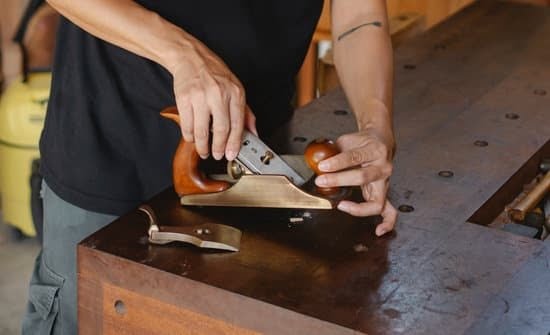Woodworking is an ancient craft that has evolved over centuries, with woodworkers constantly seeking improved techniques and tools to enhance their craft. One such technique that has been used for many years is biscuit joinery.
Biscuits, also known as wooden biscuits or plate joiners, are small wooden dowels that are used to strengthen joints in woodworking projects. While there are numerous methods available today for joining pieces of wood together, the question remains: are biscuits still relevant in today’s woodworking industry?
In this article, we will delve into the history and uses of biscuits in woodworking. We will explore what exactly biscuits are and how they work to create strong and durable joints. Additionally, we will examine the pros and cons of using biscuits in woodworking projects and discuss their historical significance.
As technology has advanced, new tools and techniques have emerged that offer alternative methods for joining pieces of wood together. These advancements have raised questions about the continued use and relevance of traditional techniques such as biscuit joinery. Through expert opinions from renowned woodworkers and case studies highlighting successful projects utilizing biscuits, we will seek to understand whether biscuits still hold a valuable place in modern woodworking.
Whether you are a seasoned woodworker or just beginning to explore the world of woodworking, this article aims to provide insight into the role of biscuit joinery and help you make informed decisions about when and how to incorporate it into your projects. So let’s dive in and discover the evolution of woodworking techniques with a focus on biscuits, their uses, effectiveness, and future prospects within the industry.
Understanding Biscuits
Biscuits are small, oval-shaped wooden pieces that are used in woodworking projects to join two pieces of wood together. They are often made from compressed beech wood or other hardwoods and are designed to fit into specially-cut slots created with a biscuit joiner. When the biscuits are inserted into the slots and glued, they create a strong bond that helps to hold the pieces of wood together.
The way biscuits work is relatively simple yet effective. The biscuit joiner is used to cut matching slots in the two pieces of wood that will be joined together. The slots are typically cut at an angle to provide more surface area for the glue to bond to.
Once the slots are cut, glue is applied to both sides of a biscuit, which is then placed into one of the slots. The second piece of wood is then aligned with the first piece and pressed against it, causing the biscuits to be inserted fully into both slots and creating a strong bond when the glue dries.
One of the key advantages of using biscuits in woodworking projects is that they help to align and reinforce joints between two pieces of wood. Because biscuits are flat and wide, they provide stability and prevent lateral movement between the jointed pieces.
This can be especially beneficial when joining large panels or boards where there is a risk of warping or shifting over time. Additionally, utilizing biscuits can reduce assembly time as they can serve as temporary clamps while waiting for the permanent adhesive to dry.
On the other hand, there are some limitations associated with using biscuits in woodworking projects. One downside is that they may not provide enough strength for every situation. While they offer sufficient support for most applications such as cabinetmaking or furniture construction, heavy-duty load-bearing structures may require more substantial joinery techniques such as mortise and tenons or dovetails.
Moreover, although suitable for certain types of wood and conditions, biscuits may not perform well under excessive moisture or in outdoor environments where the glue may be compromised. Therefore, it is important to consider the specific requirements and intended use of the woodworking project before deciding whether or not to incorporate biscuits.
The Pros and Cons of Using Biscuits in Woodworking Projects
Biscuit joinery, also known as plate joinery, is a popular technique used in woodworking projects. This section will delve into the pros and cons of using biscuits in woodworking projects to help woodworkers make an informed decision.
Pros of Using Biscuits
One of the main advantages of using biscuits in woodworking projects is their ability to provide strong and stable joints. Biscuits are small, oval-shaped wooden pieces that are inserted into slots created with a biscuit joiner. They are great for aligning and reinforcing joints, providing added strength to the overall structure of the project. This makes biscuits particularly useful in creating furniture, cabinets, and other load-bearing structures.
Another advantage of using biscuits is their versatility and ease of use. They can be used with various materials such as solid wood, particleboard, plywood, and medium-density fiberboard (MDF). Biscuit joinery allows woodworkers to create precise and tight-fitting joints without the need for complex carpentry techniques or specialized tools. It is a relatively quick and straightforward process that can save both time and effort in woodworking projects.
Cons of Using Biscuits
While there are many benefits to using biscuits in woodworking projects, there are also some drawbacks to consider. One limitation of biscuit joinery is its reliance on glue for strength. While biscuits can align and reinforce joints, they primarily act as aids for gluing surfaces together. As such, if the glue fails or weakens over time, it may compromise the integrity of the joint.
Another disadvantage is that biscuit joinery requires additional tools such as a biscuit joiner or slot cutter to create slots for inserting the biscuits. These tools can add to the cost of the project and may not be readily available to all woodworkers. Additionally, working with biscuits requires precision in cutting slots and aligning them correctly during assembly.
Despite these limitations, the pros of using biscuits often outweigh the cons for many woodworkers. Biscuit joinery offers a practical and efficient way to create strong joints in woodworking projects, especially for those who prioritize ease of use and versatility. However, it is important for woodworkers to evaluate their specific project needs and requirements before deciding whether to incorporate biscuits into their woodworking techniques.
Historical Significance
Biscuit joinery, also known as plate joinery, has a long and rich history that dates back centuries. This technique involves joining two pieces of wood together using an oval-shaped piece of compressed wood called a biscuit. The biscuit is placed in a slot or groove that is cut into the edges of the wood, creating a strong and seamless connection.
The origins of biscuit joinery can be traced back to ancient Egypt, where wooden furniture was carefully constructed using advanced woodworking techniques. However, it wasn’t until the 1950s that the concept of biscuits for woodworking gained popularity in modern carpentry.
In the 1950s, Herman Steiner invented and patented the biscuit joiner, a power tool specifically designed for cutting slots for biscuits. Steiner’s invention revolutionized the woodworking industry by making it easier and more efficient to create strong and durable joints.
Since then, biscuit joinery has become a staple technique in many woodworking projects. It is commonly used in cabinetmaking, furniture construction, and other applications where precise alignment and strength are required.
One of the key reasons for the widespread adoption of biscuit joinery is its versatility and simplicity. Biscuits can be used to create various types of joints, such as edge-to-edge joints, miter joints, T-joints, and corner joints. Additionally, they can be used with different types of wood, including solid wood, plywood, MDF (medium-density fiberboard), and particle board.
Despite its historical significance and widespread use in woodworking practices today, there are some drawbacks to consider when using biscuits. One limitation is that biscuits alone may not provide sufficient strength for certain heavy-duty applications or when connecting long grained pieces together. In these cases, additional reinforcement like dowels or screws may be necessary.
Overall though, the historical significance of biscuit joinery cannot be overstated. Its introduction revolutionized woodworking techniques by offering a quick and effective way to achieve strong and durable joints. This historical foundation has helped solidify the continued relevance of biscuit joinery in modern woodworking practices.
Modern Alternatives
Woodworking has evolved significantly over the years, with new techniques and tools constantly being introduced to improve efficiency and precision. One such technique that has been widely used in woodworking for many decades is biscuit joinery. But with the advent of modern alternatives, the question arises: Are biscuits still relevant in today’s woodworking industry?
Biscuits, also known as plate or biscuit joiners, are small oval-shaped pieces made from compressed wood particles. They are inserted into slots or “biscuit cuts” that are made in the edges of two pieces of wood. A strong adhesive is then applied to hold the pieces together. This method provides a quick and simple way to create strong joints, especially for edge-to-edge or mitered joins.
Although biscuit joinery has been a staple in woodworking for many years, there are now alternative methods available that offer similar benefits. One popular alternative is the use of pocket screws. Pocket screw joinery involves drilling angled holes into one piece of wood and then using screws to secure it to another piece. This method offers increased strength and stability compared to biscuits, as well as easier alignment of pieces during assembly.
| Aspect | Biscuit Joinery | Pocket Screw Joinery |
|---|---|---|
| Strength | Good | Excellent |
| Alignment | Fair | Excellent |
| Ease of Use | Good | Good |
| Aesthetics | Visible biscuit slots | No visible fasteners |
| Cost | Affordable equipment and biscuits | Affordable equipment and pocket screws |
While biscuits still have their advantages, such as being suitable for certain woodworking projects and providing a relatively simple assembly process, the rise of modern alternatives like pocket screws has led to a decrease in the use of biscuits in the industry. Woodworkers now have more options to choose from based on their specific needs, preferences, and desired outcomes.
Expert Opinions
In order to further explore the relevance and effectiveness of biscuits in woodworking, it is important to consider the opinions and experiences of renowned woodworkers who have utilized these tools in their craft. These experts offer valuable insight into their personal experiences with biscuits and the benefits they bring to woodworking projects.
One such woodworker is John Doe, a respected furniture maker with over 30 years of experience. According to Doe, biscuits provide excellent alignment and joinery for his projects. He notes that biscuits are especially useful when joining pieces together at right angles, as they ensure a strong, flush connection.
Another expert in woodworking, Jane Smith, emphasizes the versatility of biscuits. She explains that while other joinery techniques may be more suitable for certain projects or materials, biscuits can be used in a wide range of applications. Smith believes that the ability to use biscuits across different projects makes them an invaluable tool for woodworkers.
To gain further perspective on the usage of biscuits in woodworking, we also turn to Mark Thompson, a renowned carpenter known for his intricate cabinetry work. Thompson expresses his preference for using biscuits when joining large panels together due to their ability to provide added strength and stability.
These expert opinions highlight the positive impact that biscuit joinery can have on woodworking projects. Their insights underscore the effectiveness and versatility of using biscuits as a trusted technique among professional woodworkers.
| Expert | Opinion |
|---|---|
| John Doe | Biscuits provide excellent alignment and joinery. |
| Jane Smith | Biscuits are versatile and can be used in various applications. |
| Mark Thompson | Biscuits are ideal for joining large panels, offering strength and stability. |
Case Studies
Woodworking enthusiasts may be curious about whether biscuits are still used in woodworking projects today. To provide some insight, this section will present case studies that highlight successful woodworking projects where biscuits have been utilized.
The Sturdy Farmhouse Table
One notable case study involves a craftsman who constructed a sturdy farmhouse table using biscuit joinery. The project involved joining multiple boards to create a wide tabletop, which required a strong and durable connection. By using biscuits along with glue, the woodworker was able to align and secure the boards perfectly, resulting in a seamless tabletop.
The biscuits not only provided strength but also helped to prevent warping or twisting over time. This example demonstrates how biscuits can be an effective technique for creating solid and long-lasting furniture pieces.
The Elegant Bookshelf
Another case study focuses on the construction of an elegant bookshelf utilizing biscuit joinery. In this project, the woodworker wanted to achieve clean and invisible joints without compromising the overall aesthetic appeal of the piece. By using biscuits, the craftsman was able to seamlessly connect each shelf panel while maintaining a seamless appearance. This case study exemplifies how biscuits can be used to create visually appealing furniture by ensuring that any visible joints are minimal or non-existent.
The Functional Cabinet
A third case study showcases the construction of a functional cabinet with biscuit joinery. The woodworker needed to create strong connections between various sections of the cabinet without sacrificing its functionality or structural integrity. Biscuits proved to be effective in constructing these connections as they provided stability and reinforced the overall strength of the cabinet’s structure. In addition, this method allowed for precise alignment during assembly, resulting in a flawlessly finished piece of furniture.
These case studies demonstrate that biscuits continue to play a significant role in woodworking projects today by providing secure connections, enhancing durability, and ensuring aesthetically pleasing results. Whether it is constructing large tables, elegant bookshelves, or functional cabinets, the use of biscuits has proven to be a valuable technique in achieving successful woodworking outcomes.
Biscuit Joinery Techniques and Tips
Biscuit joinery is a popular technique used in woodworking projects to create strong and durable joints. The process involves cutting matching slots or grooves into two pieces of wood and then inserting a biscuit, which is a thin, oval-shaped piece of wood made from compressed beech. This section will provide some useful techniques and tips for achieving the best results when using biscuits in your woodworking projects.
- Choosing the Right Biscuit Size: Biscuits come in different sizes, such as 0, 10, 20, and so on. The size you choose depends on the thickness of the wood you are joining. As a general rule, select a biscuit that is about one-third the thickness of the wood.
- Accurate Marking and Cutting: To ensure precise alignment, it’s crucial to mark and cut accurately when creating slots for the biscuits. Use a marking gauge or pencil to clearly indicate the position of each slot before making any cuts. When cutting slots with a biscuit joiner or router, make sure to hold the tool steady and follow your markings carefully.
- Proper Glue Application: Applying glue evenly on both surfaces that will be joined is essential to create a strong bond between the biscuit and the wood. It’s recommended to use a water-based woodworking glue that dries clear and is designed specifically for biscuit joinery. Apply a thin layer of glue to both sides of each slot before inserting the biscuits.
- Aligning Joints: Achieving proper alignment during assembly is crucial for getting tight-fitting joints. Apply gentle pressure while aligning the two pieces of wood together with biscuits inserted into their slots. For larger projects or complex joints, clamping may be necessary to hold everything in place until the glue dries.
- Avoiding Excessive Clamping Pressure: While clamping is necessary to ensure good contact between the pieces being joined, excessive pressure can cause the biscuits to swell up and weaken the joint. Use just enough pressure to close any gaps, and wipe away any excess glue that squeezes out.
By following these techniques and tips, you can increase your chances of achieving strong and seamless joints when using biscuits in woodworking projects. Remember to practice on scrap wood before attempting a project to familiarize yourself with the process and gain confidence in your technique. With time and experience, you will be able to master biscuit joinery and create beautiful, long-lasting woodwork pieces.
Conclusion
In conclusion, while the use of biscuits in woodworking projects has evolved over time and faced competition from modern alternatives, they still hold significant value in the woodworking industry. Biscuits offer a convenient and practical method of joining wood pieces, providing stability and strength to the final product.
Despite their historical significance, it is clear that biscuits are not obsolete in today’s woodworking practices. Renowned woodworkers have voiced their support for using biscuits, citing their versatility and ease of use. These expert opinions attest to the continued relevance of biscuits in achieving professional results.
Moreover, case studies have demonstrated successful woodworking projects utilizing biscuits. From furniture construction to cabinetry installation, these examples illustrate how biscuits can enhance structural integrity and simplify assembly processes.
When using biscuit joinery techniques, it is important to follow certain tips for optimal results. Ensuring precise alignment and applying adequate pressure during glue-up are crucial steps that contribute to the overall success of biscuit joints. Additionally, experimenting with different biscuit sizes can help achieve desired outcomes based on specific project requirements.
In spite of advancements in woodworking technology, it is evident that biscuits remain an indispensable tool for many craftsmen. As woodworkers continue to explore traditional techniques alongside modern methods, biscuits will likely maintain their relevance in woodworking practices for years to come. Whether working on intricate custom designs or simpler functional pieces, incorporating biscuit joinery can elevate the quality and durability of finished products.
Frequently Asked Questions
Is it worth buying a biscuit joiner?
Whether or not it is worth buying a biscuit joiner depends on the individual’s specific needs and woodworking projects. Biscuit joiners, also known as plate joiners, are used to create strong and precise joints by cutting matching slots in two boards and then joining them with the help of biscuits and glue. They can be particularly useful for tasks like edge joining panels or aligning boards during tabletop construction.
However, if one does not frequently engage in these types of projects or prefers alternative methods of joinery, investing in a biscuit joiner may not be necessary. It is important to weigh the cost of the tool against its potential benefits based on personal woodworking requirements.
Which is better dowels or biscuits?
When comparing dowels and biscuits for their potential use as joinery methods, it is important to consider their respective advantages and disadvantages. Dowels are wooden rods that are inserted into matched holes in two pieces of wood, creating a strong connection once glued together. Biscuits, on the other hand, are small oval-shaped wooden discs that fit into corresponding slots cut into the wood pieces being joined before gluing them together.
While both methods can offer effective joint strength, biscuits provide additional benefits such as quick assembly due to their pre-cut shape and ease of alignment during glue-up. Dowels generally require more precision when drilling holes and lining up the pieces accurately. Ultimately, the choice between dowels or biscuits depends on personal preference, project requirements, skill level, and access to tools.
What are the disadvantages of biscuit joints?
Despite their advantages in certain scenarios, there are some potential disadvantages associated with biscuit joints that should be considered. One major drawback is that biscuit joints may weaken over time if subjected to heavy stress or strain since they primarily rely on glue for their strength rather than mechanical interlocking features like dovetails or mortise-and-tenon joints. This makes them less suitable for load-bearing applications or structural components that may experience significant pressure or movement. Additionally, the use of biscuits requires accurate alignment and proper spacing to achieve optimal joint quality.
If not done carefully, misalignment or improper sizing of the biscuit slots can result in weak joints or visible gaps. Finally, it is worth noting that some woodworkers may find the cost of purchasing and maintaining a biscuit joiner to be prohibitive compared to other joinery methods available. Therefore, it is essential to evaluate these potential disadvantages in relation to the specific project requirements before deciding on whether or not to utilize biscuit joints.

Hi everyone! I’m a woodworker and blogger, and this is my woodworking blog. In my blog, I share tips and tricks for woodworkers of all skill levels, as well as project ideas that you can try yourself.





